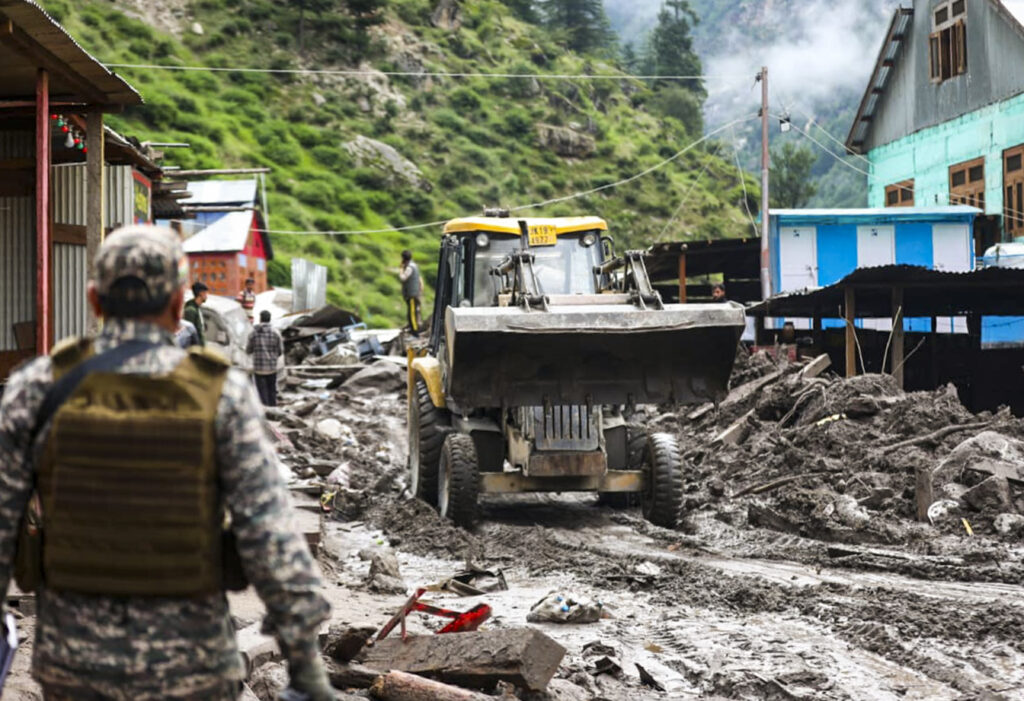Kathua Cloudburst: 4 Dead, 6 Injured as Remote J&K Village Cut Off Amid Heavy Rains
By: Javid Amin | 16 Aug 2025
Rising Himalayan Disasters and Why They Must Be Seen as Warnings
A Village in Crisis
In the quiet of the night, the remote village of Jod Ghati in Rajbagh area of Kathua district, Jammu & Kashmir, was jolted awake by a violent cloudburst. What should have been another rainy monsoon night turned catastrophic when torrents of water mixed with mud and debris swept through the settlement.
By dawn, the tragedy was clear: four lives lost, six injured, and an entire community cut off from the outside world. Homes, fields, and roads lay in ruins, while landslides in nearby Bagard and Changda villages further deepened the crisis.
Police and State Disaster Response Force (SDRF) teams rushed to the scene, but access remained a major challenge. Rising water levels in the Ujh river, dangerously close to the danger mark, added urgency to the rescue operations. The district administration quickly issued warnings, advising locals to stay away from rivers and streams swollen by relentless rain.
Human Cost of the Kathua Cloudburst
For the families of the deceased, the night was one of sudden loss and unbearable grief. Eyewitnesses recall hearing a loud rumble before torrents of water and boulders crashed down. The injured, many with fractures and deep cuts, were carried by neighbors through slippery paths to makeshift medical stations.
A local elder, trembling as he recounted the event, said:
“We heard the mountain roar. It felt like the sky had fallen on us. People ran, but there was nowhere to go.”
These voices underline that beyond statistics, real human stories of fear, loss, and resilience are unfolding in Kathua.
Geography and Vulnerability of Kathua
Kathua district, located on the southern edge of Jammu & Kashmir, is often overshadowed by the more frequently covered regions of Kashmir Valley or Ladakh. Yet, it is no less vulnerable to extreme weather.
The Rajbagh area, including Jod Ghati, sits in a transitional zone between plains and lower Himalayan hills. This geography makes it particularly prone to:
-
Flash floods when sudden heavy rainfall overwhelms small streams.
-
Landslides triggered by water loosening fragile soil and rocks.
-
Connectivity loss, as single narrow roads and bridges are easily cut off.
Unlike urban centers, these remote villages have limited infrastructure, making both disasters and relief operations harder to manage.
Why Cloudbursts Are Increasing in J&K
Meteorologists note that cloudbursts—once considered rare—are now striking more frequently across J&K. Just weeks before Kathua, Kishtwar, Pahalgam, and Kupwara reported similar calamities.
The reasons include:
-
Climate change altering rainfall patterns: Monsoon rains are becoming more erratic, with sudden intense bursts.
-
Deforestation and slope destabilization: Removing tree cover weakens natural barriers.
-
Unregulated construction: Villages and roads often cut into fragile hillsides.
-
Riverbed mining: Extraction of sand and gravel reduces rivers’ capacity to absorb sudden water surges.
The Himalayan ecosystem is under siege, and disasters like Kathua are nature’s way of showing the cracks.
Rescue and Relief Challenges
Reaching Jod Ghati was a test in itself. Torrential rain had washed away connecting roads, while landslides blocked alternate routes. SDRF teams carried equipment on foot through slippery terrain.
Immediate challenges included:
-
Evacuating injured residents to hospitals.
-
Providing food, water, and shelter to stranded families.
-
Preventing secondary disasters, as swollen rivers threatened more breaches.
Officials emphasized that restoring communication and road access is as urgent as relief, since without it, help cannot reach.
Wider Impact on the Region
While Jod Ghati bore the brunt, Bagard and Changda villages under Kathua police station also suffered from landslides. Roads cracked, electricity lines snapped, and agricultural fields were inundated.
For rural households that depend on subsistence farming, the loss of standing crops means months of economic distress. Livestock deaths add to their hardship, with many families losing their primary source of livelihood.
The rising Ujh river, nearing danger level, poses a continuing threat not just to Kathua but to downstream areas. If embankments give way, entire settlements could face flooding.
Administration’s Response
The Kathua district administration moved swiftly:
-
Rescue teams deployed with SDRF and police support.
-
Monitoring stations set up along Ujh river.
-
Public warnings issued to avoid rivers and unstable slopes.
-
Relief camps prepared for displaced families.
Deputy Commissioner Kathua stressed that “saving lives remains the priority,” while long-term rehabilitation plans are being considered.
Kathua in the Larger Pattern of Himalayan Disasters
The Kathua cloudburst is not just a local tragedy; it is part of a larger Himalayan crisis. In the past decade, disasters have increased across:
-
Uttarakhand (Kedarnath floods 2013, Joshimath subsidence 2023).
-
Himachal Pradesh (repeated monsoon flash floods).
-
Jammu & Kashmir (2014 floods, recurring cloudbursts).
Experts say the message is clear: unless human interference is curbed, the Himalayas will continue to bleed.
The Way Forward — Lessons from Kathua
The Kathua disaster offers urgent lessons:
-
Strengthen early warning systems with community-level alerts.
-
Ban illegal mining that weakens rivers.
-
Promote eco-sensitive construction with slope stabilization.
-
Involve local communities in disaster preparedness drills.
-
Integrate climate adaptation into all regional planning.
Relief is important, but prevention is life-saving.
Bottom-Line: A Warning We Cannot Ignore
The cloudburst in Kathua is a reminder that every Himalayan village is vulnerable. The deaths of four villagers may appear small compared to bigger tragedies, but for their families, it is a universe lost.
As the Ujh river swells and monsoon rains continue, Kathua stands as both a tragedy and a warning. It is time to act—not after each disaster, but before the next one strikes.



